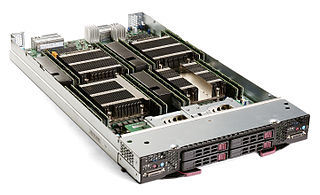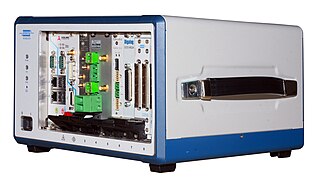
A field-programmable gate array (FPGA) is a type of configurable integrated circuit that can be repeatedly programmed after manufacturing. FPGAs are a subset of logic devices referred to as programmable logic devices (PLDs). They consist of an array of programmable logic blocks with a connecting grid, that can be configured "in the field" to interconnect with other logic blocks to perform various digital functions. FPGAs are often used in limited (low) quantity production of custom-made products, and in research and development, where the higher cost of individual FPGAs is not as important, and where creating and manufacturing a custom circuit wouldn't be feasible. Other applications for FPGAs include the telecommunications, automotive, aerospace, and industrial sectors, which benefit from their flexibility, high signal processing speed, and parallel processing abilities.

In computing, an expansion card is a printed circuit board that can be inserted into an electrical connector, or expansion slot on a computer's motherboard to add functionality to a computer system. Sometimes the design of the computer's case and motherboard involves placing most of these slots onto a separate, removable card. Typically such cards are referred to as a riser card in part because they project upward from the board and allow expansion cards to be placed above and parallel to the motherboard.

A single-board computer (SBC) is a complete computer built on a single circuit board, with microprocessor(s), memory, input/output (I/O) and other features required of a functional computer. Single-board computers are commonly made as demonstration or development systems, for educational systems, or for use as embedded computer controllers. Many types of home computers or portable computers integrate all their functions onto a single printed circuit board.
A PCI Mezzanine Card or PMC is a printed circuit board assembly manufactured to the IEEE P1386.1 standard. This standard combines the electrical characteristics of the PCI bus with the mechanical dimensions of the Common Mezzanine Card or CMC format.
JTAG is an industry standard for verifying designs of and testing printed circuit boards after manufacture.

Xilinx, Inc. was an American technology and semiconductor company that primarily supplied programmable logic devices. The company is known for inventing the first commercially viable field-programmable gate array (FPGA). It also created the first fabless manufacturing model.

A blade server is a stripped-down server computer with a modular design optimized to minimize the use of physical space and energy. Blade servers have many components removed to save space, minimize power consumption and other considerations, while still having all the functional components to be considered a computer. Unlike a rack-mount server, a blade server fits inside a blade enclosure, which can hold multiple blade servers, providing services such as power, cooling, networking, various interconnects and management. Together, blades and the blade enclosure form a blade system, which may itself be rack-mounted. Different blade providers have differing principles regarding what to include in the blade itself, and in the blade system as a whole.

PC/104 is a family of embedded computer standards which define both form factors and computer buses by the PC/104 Consortium. Its name derives from the 104 pins on the interboard connector (ISA) in the original PC/104 specification and has been retained in subsequent revisions, despite changes to connectors. PC/104 is intended for specialized environments where a small, rugged computer system is required. The standard is modular, and allows consumers to stack together boards from a variety of COTS manufacturers to produce a customized embedded system.

PCI eXtensions for Instrumentation (PXI) is one of several modular electronic instrumentation platforms in current use. These platforms are used as a basis for building electronic test equipment, automation systems, and modular laboratory instruments.
A computer-on-module (COM) is a type of single-board computer (SBC), a subtype of an embedded computer system. An extension of the concept of system on chip (SoC) and system in package (SiP), COM lies between a full-up computer and a microcontroller in nature. It is very similar to a system on module (SOM).

COM Express, a computer-on-module (COM) form factor, is a highly integrated and compact computer that can be used in a design application much like an integrated circuit component. Each module integrates core CPU and memory functionality, the common I/O of a PC/AT, USB, audio, graphics (PEG), and Ethernet. All I/O signals are mapped to two high density, low profile connectors on the bottom side of the module. COM Express employs a mezzanine-based approach. The COM modules plug into a baseboard that is typically customized to the application. Over time, the COM Express mezzanine modules can be upgraded to newer, backwards-compatible versions. COM Express is commonly used in Industrial, military, aerospace, gaming, medical, transportation, Internet of things, and general computing embedded applications.

VPX, also known as VITA 46, is a set of standards for connecting components of a computer, commonly used by defense contractors. Some are ANSI standards such as ANSI/VITA 46.0–2019. VPX provides VMEbus-based systems with support for switched fabrics over a new high speed connector. Defined by the VMEbus International Trade Association (VITA) working group starting in 2003, it was first demonstrated in 2004, and became an ANSI standard in 2007.

Datacube Inc. was an American computer company active from 1978 to 2005. The company focused on products for image processing, developing real-time hardware and software products for the industrial, medical, military and scientific markets. Datacube's MaxVideo line of image processors enjoyed a high market share in the image processing field owing to its modularity. The company was also responsible for a number of industry firsts, including the first single-board frame grabber and the first real-time image convolver.
ESMexpress is a very compact computer-on-module (COM) standard. It is a complete processor module that currently supports several low-power Intel and PowerPC platforms. Apart from a CPU component, every module also includes memory and a range of serial communication interfaces such as PCI Express, Gigabit Ethernet, USB, SATA, SDVO, LVDS and HD audio. These interfaces are defined in the form factor's specification, and signals are assigned to two 120-pin connectors. This fixed pin mapping ensures that different ESMexpress modules can be exchanged more easily. Consequently, ESMexpress typically does not have an onboard FPGA. The idea behind this is to implement very specialized functions in an FPGA on the COM's carrier board to ease upgrades of the system CPU through exchange of the ESMexpress module.

Embedded System Module, or ESM, is a compact computer-on-module (COM) standard. An ESM module typically includes a CPU processor, memory, module-specific I/O interfaces and a number of basic front I/O connectors. They can be plugged on a carrier board or be used as a stand-alone processor card.
WinSystems is an employee owned embedded systems manufacturer specializing in ruggedized, highly reliable industrial computer systems. The company was founded by Jerry Winfield in 1982 and is headquartered in Grand Prairie, Texas.
In the electronics industry, embedded instrumentation refers to the integration of test and measurement instrumentation into semiconductor chips. Embedded instrumentation differs from embedded system, which are electronic systems or subsystems that usually comprise the control portion of a larger electronic system. Instrumentation embedded into chips is employed in a variety of electronic test applications, including validating and testing chips themselves, validating, testing and debugging the circuit boards where these chips are deployed, and troubleshooting systems once they have been installed in the field.

Mistral Solutions Pvt. Ltd. is a privately held product design and systems engineering company with a focus on embedded domains. Founded in 1997 by Anees Ahmed and Rajeev Ramachandra, the Indian company was acquired by Axicades Technologies in December 2022.
VEGA Microprocessors is an initiative to develop a portfolio of microprocessors, and their hardware ecosystem, by the Centre for Development of Advanced Computing (C-DAC) in India. The portfolio includes several indigenously-developed processors based on the RISC-V instruction set architecture (ISA).











